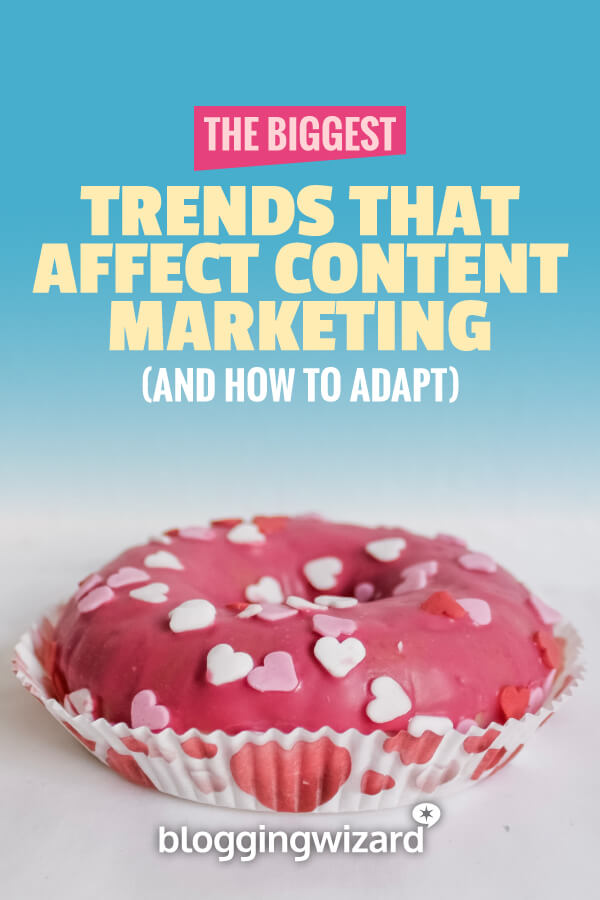The Biggest Technology Trends That Affect Content Marketing (And How To Adapt)

Every year, Chief Marketing Technologist Scott Brinker releases his annual supergraphic showing the number of technology products and services on the market.
Although it’s referred to as the “Martech 5000” you can see the phenomenal growth in the technology landscape over the past eight years from 150 to 7,040 solutions:
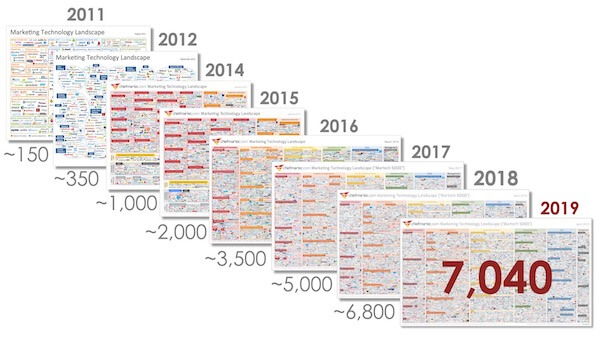
Content Marketing is one part of the landscape, alongside social media, data management, ecommerce, and many more:
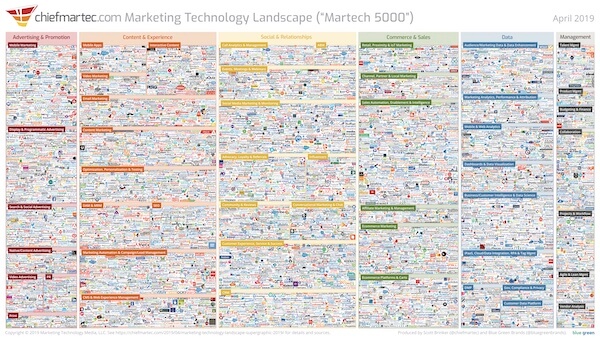
[Check out the full-size 2019 Marketing Technology Landscape Supergraphic.]
In this article, we’ll take a look at the biggest technology trends that impact content marketing and how you can adapt to them.
Which technology trends impact content marketing nowadays?
Here are four trends to consider:
- Artificial Intelligence (AI)
- Voice search is taking over
- Mind the Skills Gap
- Don’t forget the Golden Oldies
AI and Bots are definitely trending, and make it easier for you to personalize content. AI can gather and interpret huge amounts of data in seconds. This helps content marketers to learn more about their audiences and deliver the content they want.
Talkwalker released a new market-leading AI technology feature to their social listening platform that lets clients track brand mentions across video as well as just text and image.
Voice Search continues to grow in popularity. To get a complete overview, be sure to check out our article on voice search statistics.
But new technologies often result in a skills gap because the workplace can’t keep pace with developments. So it’s important for content marketers to learn how to use and embrace the new technology.
And just because new technologies are emerging, don’t ignore the golden oldies. According to the CMI Tech Content Marketers Research, established technologies are widely used by tech marketers:
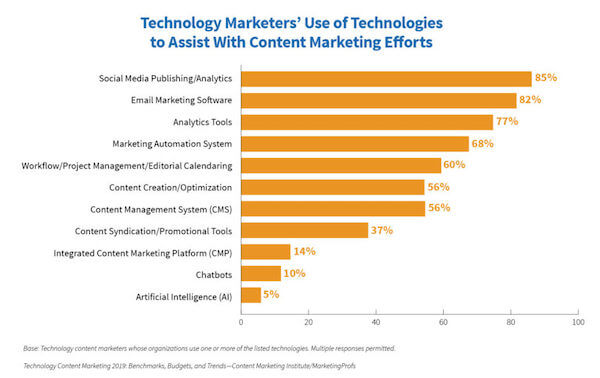
- Social media (85%)
- Email marketing (82%)
- Analytics (77%)
- Marketing automation (68%)
- Workflow/project management/calendar tools (60%)
- Content creation/optimization (56%)
- Content management (56%)
As a side note, if you’d like to learn more about marketing automation, check out our article on marketing automation statistics.
What should your business be doing to adapt to those trends?
Let’s take a look at how your business can use these technology trends.
Artificial Intelligence (AI)
Artificial Intelligence is here to help us. Not take over our jobs.
Use AI to create personalized content based on demographics, interests, shopping behavior, location, etc. Here’s a useful post by Elise Dopson on how to maximize AI and Content Marketing.
Voice Search
More people are using their mobile devices and digital assistants like Alexa to find the answers to their questions. That usually means they receive their answer from the top-ranking result, often without seeing it or clicking on it.
Voice search queries are longer (3-5 words) than text search (1-3 words) and are mainly questions:
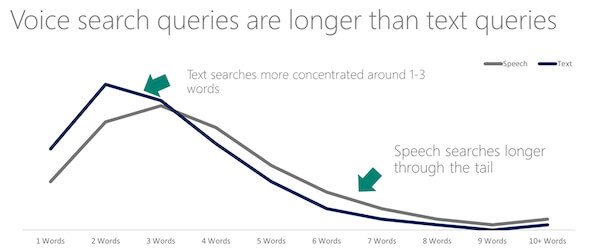
When you’re creating content, think about the type of questions users are likely to ask and then answer them. As Ann Smarty says, spoken search queries are often:
- Long
- Spontaneous
- Consist of full sentences (usually questions)
So you have to optimize your content:
- Think about the Search Intent – the underlying reason behind a search query.
- Aim to get Featured Snippets – the ‘special search result’ you sometimes see above the normal search results at the top of Page 1 in Google.
- Use Schema Structured Data – the ‘media rich snippet’ between the URL and the description, including images, ratings, authors, votes, cooking time, calories, and more:

Content marketing isn’t just blogging …
It’s easy to think that content marketing is all about blogging. But that’s not the case.
Use different channels, formats, and mediums to suit your audience and objective.
Social media
It’s not only a case of selecting which social media networks to use, but also choosing the right format for your content. For instance, Instagram regularly brings out new features for users to publish content and engage with their audience, especially with Stories.
Instagram Stories are growing 15x faster than the traditional ‘Image and Caption’ posts, so it’s no surprise the network had 500 million daily active Stories users worldwide in Jan 2019:

Email marketing
Not a new technology, but still trending. Email marketing campaigns provide tremendous ROI – in the US it’s $44 for every $1 spent. And when you add automation into the mix, then you get even better returns as you can send timely and relevant content.
The email marketing benchmarks report from GetResponse shows that automated emails have higher open and click-through rates than regular newsletters:
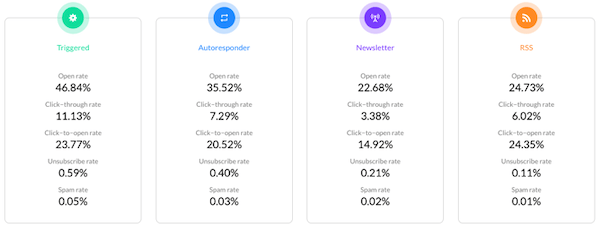
Video marketing
You can’t escape the fact that video is now a huge part of our online lives:
- Almost 5 billion videos are watched on Youtube every single day.
- Average daily video views on Facebook are now over 8 billion.
Whether you use live video such as Facebook Live or create product videos and tutorials for YouTube, video marketing can be an effective way to engage and educate your audience.
Podcasting
Not everyone has the time to read blog content, but they do have time to listen to content, perhaps during their daily commute to work or while doing household chores. That’s one of the reasons podcasts have become more popular, and why content marketers use this medium to communicate their message.
According to figures from Statista, 70% of Americans are now familiar with the term “podcasting” and more than 50% have listened to a podcast:
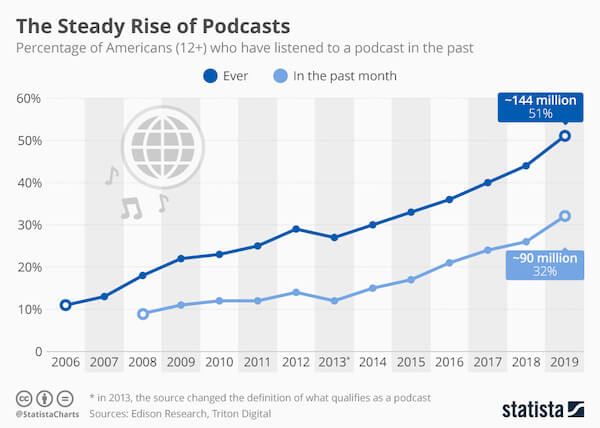
You can learn more in our roundup of podcasting stats & trends.
Augmented Reality (AR)
YouCam Makeup – the award-winning AR beauty app from YouCamApps – lets users try out various types of makeup.
Or if you want to get really creative, why not create an Augmented Reality (AR) Business Card?
LinkedIn user Vandana (Didi) created a post saying:
Hi LinkedIn – I recently graduated and currently in the market for new employment. I’ve made an interactive business card experimenting with Augmented Reality to display my portfolio, a couple of projects and social media links. Please take a look and let me know what ya’ll think!
What’s the future of content marketing?
With all these new technology trends what is the industry going to look like in five or ten years? Nobody knows for sure, but here are three things to implement in your content strategy and planning.
Optimized content
Content marketing has to change. Right now, content production outweighs demand. We’re in danger of flogging it to death unless we change. As @justinleejw says:
Publish less. Publish well. Publish only when you have something valuable to say.
Optimize existing content instead of publishing new content. For example:
- Refresh meta titles and descriptions.
- Improve the quality of your copy, including headlines and CTAs.
- Check internal and external links are working and up-to-date.
- Enhance images and videos.
User-generated content (UGC)
Consumers want genuine content, so expect to see more user-generated content (UGC).
Useful and personal content
Advanced technologies like AI and Bots exist to help us generate helpful content that people want. They can complement our efforts to make content more personalized, and ironically, more human.
Final thoughts
New content marketing technologies are emerging all the time. The key is to choose which ones to focus on for your business and make sure you have the skills to maximize them.
If you want your content marketing to succeed:
- Make your content useful and personal.
- Use different types and formats of content.
- Learn from the past and quickly adapt to the present.

